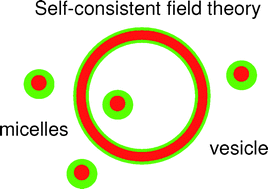Field theoretical modeling of the coexistence of micelles and vesicles in binary copolymer mixtures
Abstract
Using the self-consistent field (

* Corresponding authors
a
Laboratory of Physical Chemistry and Colloid Science, Wageningen University, Dreijenplein 6, Wageningen, The Netherlands
E-mail:
Frans.Leermakers@wur.nl
b Laboratory of Organic Chemistry, Wageningen University, Dreijenplein 8, Wageningen, The Netherlands
c Laboratory of Nano-organic chemistry, Department of Chemical Engineering ‘DelftChemTech’, Delft University of Technology, Julianalaan 136, Delft, The Netherlands
Using the self-consistent field (

 Please wait while we load your content...
Something went wrong. Try again?
Please wait while we load your content...
Something went wrong. Try again?
F. Li, A. T. M. Marcelis, E. J. R. Sudhölter, M. A. Cohen Stuart and F. A. M. Leermakers, Soft Matter, 2009, 5, 4173 DOI: 10.1039/B904525B
To request permission to reproduce material from this article, please go to the Copyright Clearance Center request page.
If you are an author contributing to an RSC publication, you do not need to request permission provided correct acknowledgement is given.
If you are the author of this article, you do not need to request permission to reproduce figures and diagrams provided correct acknowledgement is given. If you want to reproduce the whole article in a third-party publication (excluding your thesis/dissertation for which permission is not required) please go to the Copyright Clearance Center request page.
Read more about how to correctly acknowledge RSC content.
 Fetching data from CrossRef.
Fetching data from CrossRef.
This may take some time to load.
Loading related content
